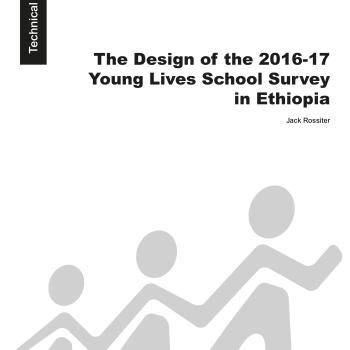Publication Information

Young Lives school surveys gather detailed information about children, their households, their teachers and their schools. School surveys seek to develop understanding of the contribution of educational experience in relation to the causes and consequences of childhood poverty.
The first Ethiopia school survey, conducted in 2009/10, tracked Young Lives’ ‘Younger Cohort’ children into schools and classrooms to understand their educational experiences, attainment and achievement levels (Young Lives 2012).
A second school survey, in 2012/13, was structured to collect data relating to all Young Lives children and their peers studying in Grades 4 and 5 in every school within Young Lives’ 20 sites (in Amhara, Oromia, SNNP, Tigray and Addis Ababa) and in an additional 10 sites in Afar and Somali. This research design extended the survey’s reach, in order to generate rich evidence about school and classroom effectiveness and the drivers of learning (Young Lives 2014).
The third Ethiopia school survey, being delivered in 2016/17 and the focus of this design note, will follow the research design adopted in 2012/13. Young Lives will visit the same sites and, within these, the same schools and will maintain our interest in school effectiveness, the levels, changes and drivers of learning. The team will survey students in Grades 7 and 8: the final grades of primary schooling and a crucial juncture before students proceed to general secondary education.
Priority areas for upper primary and lower secondary education policy have been identified through consultation with the Government of Ethiopia’s Ministry of Education and with national and international education stakeholders. These guide our main research questions:
At what level are students performing in core curricular and transferable domains (Mathematics and Functional English) and are levels indicative of preparedness for further education and training? How much progress are children making in one academic year and what are the drivers of learning trajectories over time, including how these relate to equity (e.g. are gaps growing or shrinking)? What is the role of key dimensions of education quality in shaping educational outcomes over time and, in particular, which teacher practices are associated with improved learning outcomes? What are the relationships between language of instruction (intended and applied), participation, learning levels and preparedness for further education and training in secondary grades?
This design note outlines the context and policy background, the research design, and the policy implications of the third Ethiopia school survey.

Young Lives school surveys gather detailed information about children, their households, their teachers and their schools. School surveys seek to develop understanding of the contribution of educational experience in relation to the causes and consequences of childhood poverty.
The first Ethiopia school survey, conducted in 2009/10, tracked Young Lives’ ‘Younger Cohort’ children into schools and classrooms to understand their educational experiences, attainment and achievement levels (Young Lives 2012).
A second school survey, in 2012/13, was structured to collect data relating to all Young Lives children and their peers studying in Grades 4 and 5 in every school within Young Lives’ 20 sites (in Amhara, Oromia, SNNP, Tigray and Addis Ababa) and in an additional 10 sites in Afar and Somali. This research design extended the survey’s reach, in order to generate rich evidence about school and classroom effectiveness and the drivers of learning (Young Lives 2014).
The third Ethiopia school survey, being delivered in 2016/17 and the focus of this design note, will follow the research design adopted in 2012/13. Young Lives will visit the same sites and, within these, the same schools and will maintain our interest in school effectiveness, the levels, changes and drivers of learning. The team will survey students in Grades 7 and 8: the final grades of primary schooling and a crucial juncture before students proceed to general secondary education.
Priority areas for upper primary and lower secondary education policy have been identified through consultation with the Government of Ethiopia’s Ministry of Education and with national and international education stakeholders. These guide our main research questions:
At what level are students performing in core curricular and transferable domains (Mathematics and Functional English) and are levels indicative of preparedness for further education and training? How much progress are children making in one academic year and what are the drivers of learning trajectories over time, including how these relate to equity (e.g. are gaps growing or shrinking)? What is the role of key dimensions of education quality in shaping educational outcomes over time and, in particular, which teacher practices are associated with improved learning outcomes? What are the relationships between language of instruction (intended and applied), participation, learning levels and preparedness for further education and training in secondary grades?
This design note outlines the context and policy background, the research design, and the policy implications of the third Ethiopia school survey.

